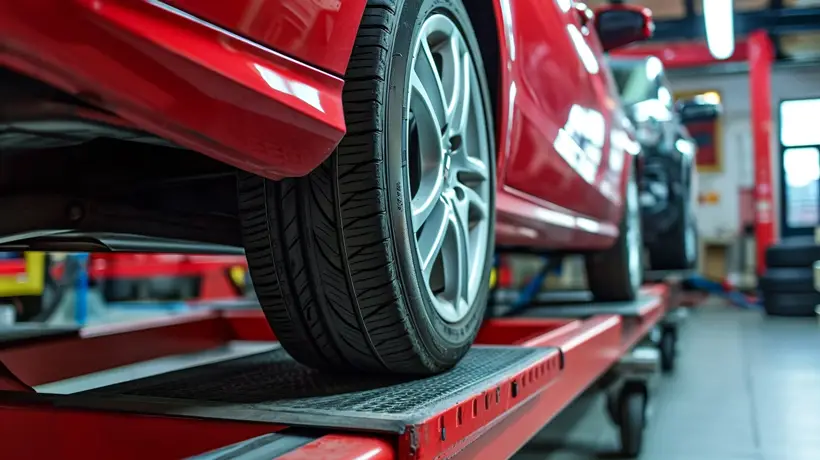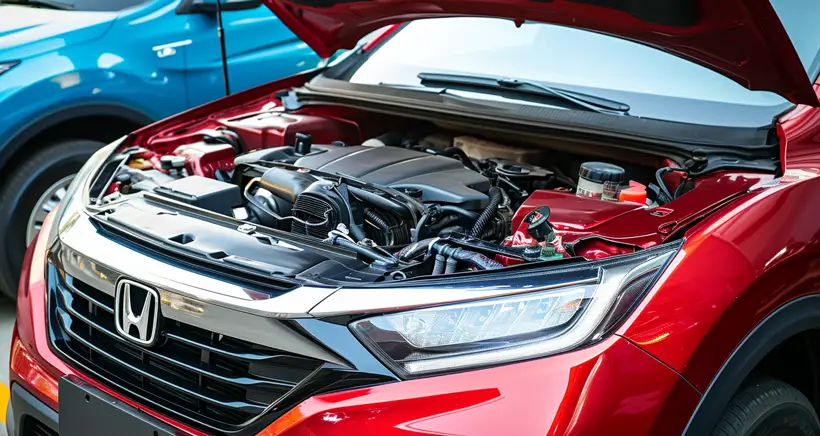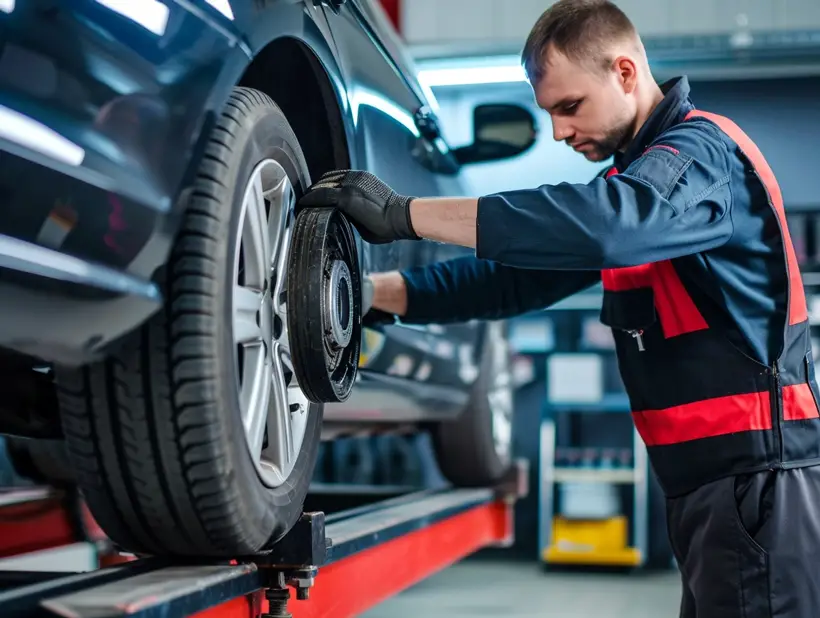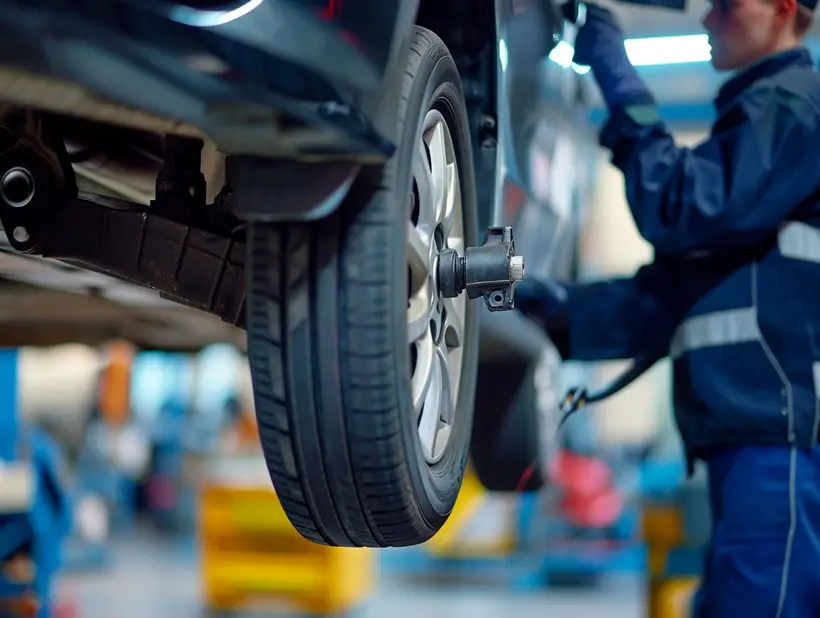Ever had that unnerving feeling when your car starts veering to one side while you’re cruising down the highway? It’s not just you‚Äîit’s a common issue that can signal an alignment or suspension problem. I’ve been there, and trust me, it’s something you’ll want to get checked out sooner rather than later.
Diagnosing the root cause is crucial because driving with poor alignment or a faulty suspension system can lead to bigger headaches down the road. I’ll walk you through the telltale signs and possible culprits behind your car’s wayward behavior, so you can hit the road with confidence again.
Signs of a Car Pulling to One Side
When I hit the road, my expectation is a smooth, straight drive unless I decide otherwise. However, a car veering off course on its own is a clear signal something’s amiss. Recognizing the signs early can save my pocket from heavy repair bills down the line.
Perhaps the most noticeable indicator is the steering wheel’s position while driving. Ideally, it should remain centered, but if I find myself having to hold it at an angle just to keep straight, there’s likely an issue. Uneven tire wear is another tell-tale sign. If I inspect my tires and see that one side is wearing down faster than the other, this could point toward an alignment problem.

Subtle cues, like uneven braking or a wobbly steering wheel, often accompany a misalignment. I might feel a slight pull to one side during acceleration or braking, which shouldn’t be ignored. Moreover, if I hear strange noises from the tires or suspension, it’s a valuable hint that something isn’t working properly.
It’s essential to keep in mind that these symptoms can escalate quickly, affecting the car’s overall drivability and safety. Regular maintenance checks are crucial, and paying attention to how my vehicle handles is the first line of defense against more significant issues.
Observing how my car behaves over different types of surfaces can also provide insights. A car might seem fine on a smooth highway but show its true colors on a bumpy road. Varying conditions often bring out underlying problems, compelling me to seek professional service to protect both the car’s integrity and my safety on the road.
Importance of Diagnosing the Issue

When I notice my car veering to one side, I immediately think about the safety implications. Ignoring this problem not only puts me at risk but also other drivers and pedestrians. Proper diagnosis is crucial for my peace of mind and everyone’s safety on the road.
Diagnosing an alignment or suspension issue starts with a thorough inspection. I’m looking for signs of wear on the suspension components, which might indicate that parts have given out due to stress or damage. If the problem lies in the wheel alignment, I’d notice discrepancies in the wheel angles, which are pivotal for keeping my car on a straight path.
Throughout my years of driving, I’ve learned that the sooner I address such issues, the sooner I’m back on the road without worries. Here’s what a diagnostic procedure typically covers:
- Visual assessment to check for physical signs of misalignment or suspension damage
- Tire examination for uneven wear patterns
- Steering tests to gauge if the issue is alignment-related or if there are deeper suspension problems
- A review of the car’s history, because past incidents like potholes or curb hits can lead to alignment issues
Driving behavior can be a telltale sign as well; I’ll often pay attention to how my car behaves on a flat road. Does it drift when I briefly let go of the steering wheel? I use this simple test to gauge alignment accuracy.
I also keep a close eye on steering response and corner handling characteristics. A delayed or sloppy response could suggest that it’s not just the alignment at fault but possibly worn steering components. Even slight changes in how my car turns corners can clue me in on potential suspension issues.
Regular checks and addressing these problems proactively can save me from expensive repairs and extend the life of the car. Spotting the signs early means simpler adjustments rather than extensive overhauls later on. I make it a habit to check in with a trusted mechanic if I’m ever in doubt, ensuring that every journey in my vehicle is as smooth and safe as possible.
Possible Causes of a Car Pulling to One Side
When my car starts veering off in one direction, I immediately realize it’s a red flag for potential issues. Tackling this symptom head-on involves understanding the common culprits. At the top of the list is tire pressure disparity. It’s straightforward ‚Äì unequal tire pressure can cause the car to pull to the side with the less inflated tires. Regularly checking and maintaining equal pressure is a simple way to prevent this problem.
But it’s not always about the pressure. Sometimes, the tires themselves are the problem. I’ve learned that uneven tire wear or mismatched tires can also cause a car to drift. It‚Äôs an easily overlooked issue, but a quick visual check can often confirm if tire condition might be leading to that annoying pull.

Looking beyond the tires, wheel alignment is frequently misunderstood. Malaligned wheels, resulting from hitting a curb or pothole, can force the steering to compensate, hence the drift. However, wheel alignment isn’t the sole player here. The car’s suspension system plays a pivotal role too. Worn out struts or shocks, damaged springs, or a bent control arm can lead to a misalignment that‚Äôs not directly related to the wheel alignment process.
Then there’s brake system malfunction, particularly a sticking caliper. Acting like a clamp, it could be causing drag on one side, pulling your car toward it. In my experience, this issue is sometimes identifiable by a burning smell after driving, or the vehicle pulling to one side when braking.
Additionally, steering system issues, such as a failing tie rod or problematic power steering rack, can’t be ruled out. These components are key to smooth steering and, if faulty, could be directly influencing the direction of your travel.
To unravel the mystery of a one-sided pull, a comprehensive evaluation of these points will often point me in the right direction. Keeping an eye on these potential issues and addressing them quickly is vital for maintaining the health of the vehicle and ensuring a safe driving experience. Discussing any recurring issues with a reliable mechanic can provide clarity and a path to getting your car running straight again.
1. Alignment Problems
When my car started veering to the left, I knew alignment issues could be to blame. Wheel alignment comprises three main criteria: camber, caster, and toe. If any of these are skewed, it can lead to the vehicle drifting or pulling to one side. Typically, alignment problems stem from everyday driving incidents such as hitting potholes, bumping into curbs, or normal wear and tear on vehicle suspension. Over time, the strain can knock your car’s suspension out of its precisely calibrated positions, leading to noticeable handling issues.
Ensuring correct tire alignment is paramount for safe driving. Misalignment doesn’t just cause your car to pull; it can also result in uneven tire wear, which can further exacerbate handling problems and compromise tire integrity. Regular alignment checks are key in preventing such issues. Most automakers recommend having an alignment check every 6,000 miles or with every oil change. However, if you’re experiencing symptoms such as your car pulling to one side or abnormal tire wear, it’s best to have the alignment checked sooner.
I always suggest that car owners perform visual inspections of their tires. If you notice that the tires have uneven wear, with one side looking more worn than the other, this is a telltale sign that the alignment is off. Another tell for misalignment is if your steering wheel is off-center when driving straight. It‚Äôs a subtle but clear indication that it’s time for a professional assessment.
Mechanics have specialized equipment to diagnose and correct alignment issues. They’ll perform an alignment service, which involves adjusting the vehicle’s suspension ‚Äì not just the tires or wheels. The goal is to realign the angles to their proper settings, ensuring your vehicle drives straight and reduces tire wear. This corrective measure not only helps you avoid further damage to your tires but also improves overall vehicle handling and safety.
Frequent check-ups and addressing alignment issues early can save you money and keep your car performing its best. Plus, it’s reassuring to drive knowing that everything is functioning as it should, providing a smoother and safer ride. Remember, when it comes to alignment, precision is key for the longevity of your tires and optimal vehicle performance.
2. Suspension Issues
When a vehicle starts veering to one side, the culprit might not always lie with the wheel alignment. Suspensions, tasked with supporting your car and keeping tires firmly planted on the road, can also cause a car to pull if there’s a problem. Understanding these issues can be tough, but I’m here to break it down for you.
Suspension components such as springs, shock absorbers, and struts are critical to a car’s stability and handling. If any of these parts wear out or fail, the balance of your vehicle is thrown off. This imbalance often results in the car pulling to one side. Think of it like running with one shoe; you’re naturally going to lean to the side that’s off balance.

Another potential suspension-related issue could be damaged control arms or bushings. These parts essentially hold the wheels steady while allowing for up and down movement. If they’re worn or damaged, your wheels can shift out of place, causing that side of the car to sag and leading to pulling.
Bent suspension components are also not out of the ordinary. They can stem from pothole encounters or accidental run-ins with curbs. Such impacts can bend parts like tie rods, control arms, or even spindle connections, leading to misalignment and pulling.
I’ve seen a variety of symptoms indicating a troubled suspension, including:
- Unusual noises when driving over bumps or turning
- A corner of the car sitting lower than the others
- A general feeling of ‘looseness’ or instability in the steering
If you’re experiencing any of these, it‚Äôs best to get your suspension checked out. Mechanics can perform tests to determine the exact cause of the issue and can use their expertise to restore your car’s suspension to its proper function.
A well-maintained suspension system not only provides a smoother ride but also helps prevent your car from pulling to one side. Regular checks and timely repair or replacement of worn-out parts are vital for the longevity of your car’s suspension and, by extension, your safety on the road. Remember, the health of your vehicle is reflected in its performance and having a dependable suspension system is central to that performance.
Diagnosing Alignment Problems
When I’m behind the wheel and notice my car veering to one side, it’s often a clear-cut sign that there’s a problem with wheel alignment. To accurately diagnose this issue, I start by examining the tire wear patterns. Uneven wear on one side of the tire versus the other can indicate poor alignment. It’s these subtle details that can reveal the larger issues at play.
For a more in-depth assessment, I recommend getting a professional wheel alignment check. Mechanics use state-of-the-art technology, like computerized alignment machines, which provide precise measurements of the wheel angles. These measurements are crucial because they reveal how much your wheels deviate from the manufacturer’s recommended specifications.
The key measurements checked during an alignment are camber, toe, and caster. Camber is the inward or outward tilt of the tire when viewed from the front of the vehicle. Toe alignment refers to the direction the tires point, relative to one another, and caster is the angle of the steering pivot, viewed from the side of the vehicle. Any discrepancies in these areas could be the reason my car pulls to one side.

Wheel alignment isn’t just about achieving a comfortable drive; it’s also about ensuring the longevity of your tires and the safety of your driving experience. When the wheels are improperly aligned, they don’t work together as they should, and this significantly increases tire wear. It also affects the vehicle’s fuel efficiency and may even jeopardize the effectiveness of the steering and suspension systems.
That’s why, after hitting a deep pothole or experiencing a minor fender bender, I’ll always take the time to schedule an appointment with a trusted mechanic. Proactive checks like these can prevent your car from developing more severe handling issues over time. Remember, the costs associated with a simple alignment are much less compared to the expense of replacing worn tires or dealing with potential suspension damage caused by ongoing misalignment.
Diagnosing Suspension Issues
When I notice my car veering to one side, I know it’s time to check not only the alignment but also the possibility of suspension problems. Steering and suspension are interrelated and both are crucial for a smooth and controlled driving experience. It’s essential to understand that while wheel alignment might cause the car to pull, it’s often a symptom of deeper suspension issues.
The first step in diagnosing suspension problems is a visual inspection. I look for signs such as:
- Leaking shocks or struts
- Broken or worn suspension components
- Uneven tire wear that differs from the patterns associated with alignment issues
Upon noticing any of these issues, I don‚Äôt delay in taking a closer look. A leaky shock absorber isn’t just about a messy driveway‚Äîit can significantly affect the car’s handling and safety. I also check for sagging springs which can cause the vehicle to sit unevenly, thus throwing off the alignment.
Another key aspect is the ride quality. If I’m experiencing an unusually bumpy ride or if the car continues to bounce after hitting a bump, there’s likely a problem with the suspension system. This is because the suspension is designed to absorb shocks and provide a smooth ride, so any ongoing discomfort suggests that the system isn’t operating as it should.
During test drives, I pay close attention to how the vehicle behaves on turns and when braking. If the car dives forward or leans excessively to one side during these maneuvers, it may indicate worn suspension components. These issues can escalate quickly, and identifying the root cause early can save time and money.
I’ve learned that addressing suspension problems promptly minimizes further damage to the vehicle. A failing suspension component not only causes the car to pull to one side but also places additional strain on other components, potentially leading to more extensive repairs. That’s why I schedule an appointment with professional mechanics who have the right tools to conduct a comprehensive inspection and ensure every part of the suspension system is in top condition. They can identify issues that aren’t always apparent during a DIY inspection.
Regular maintenance checks are a preventive measure to avoid sudden suspension failures. By keeping a check on the health of suspension components, I ensure that my vehicle remains reliable and safe on the road.
Steps to Fix Alignment Problems
When I notice my car pulling to one side, my first thought is to check the alignment. It might sound daunting, but fixing alignment issues isn’t always a complex task. Here’s what I generally do to get my vehicle back on the straight and narrow.
First, I schedule an appointment with a reputable mechanic. Considering the specialized equipment required to adjust alignment, it’s best left to the professionals. During a typical alignment service, the mechanic will adjust the angles of the wheels so that they’re perpendicular to the ground and parallel to each other. This ensures the tires make contact with the road appropriately.
Before the mechanic gets started, I find it helpful to inform them of specific symptoms. For example, is the car pulling to the right or the left? Is there uneven tire wear, or has the car been through a recent pothole mishap? This information can guide their diagnosis, potentially saving time and ensuring accuracy.
Once in the shop, the mechanic will carry out a series of steps:
- Vehicle Suspension Check: This is to ensure no underlying suspension components are contributing to the alignment issue.
- Tire Inspection and Pressure Adjustment: Uneven wear or incorrect tire pressure can lead to misalignment.
- Alignment Measurements: Using advanced machinery, they’ll measure the camber, caster, and toe of my car’s wheels.
- Adjustments: They’ll make precise changes to bring these measurements within the vehicle manufacturer’s specifications.
Throughout the repair process, I keep an eye on two critical factors: the quality of replacement parts and the technology used. Opting for high-quality parts and a shop with updated alignment equipment can make a significant difference in the longevity and accuracy of the alignment work.
Even after the alignment’s corrected, I remind myself that regular maintenance is key. Potholes and general wear and tear can throw a car off balance over time, so I make it a point to include alignment checks in my car’s maintenance routine. This simple step can prevent minor issues from escalating and help ensure I’m never caught off guard by a wayward car again.
Steps to Fix Suspension Issues
When you’re dealing with suspension issues that may be causing your car to veer to one side, it’s crucial to delve into the necessary repair steps. I’ve learned that addressing these can be a bit complex and typically require the attention of a skilled mechanic. Professional assistance is not just suggested; it’s often imperative to ensure your safety and the longevity of your vehicle.
If you suspect suspension problems, the first step is setting up an appointment with a trusted mechanic. You’ll want to describe the symptoms you’ve noticed, as this will give them a head start on diagnosing the problem. For instance, if you’ve observed that your car leans to one side or you hear unusual noises when going over bumps, let them know.
Upon arrival, the mechanic will likely conduct a thorough inspection of your suspension system. During this process, they’ll check for:
- Leaks in the shocks or struts
- Worn or damaged springs
- Bushings that may need replacement
- Any abnormal tire wear patterns that suggest uneven weight distribution
Once they identify the issue, they‚Äôll explain the necessary repairs. If you have worn shocks or struts, technicians will replace these components with new, quality parts to restore stability and comfort to your ride. Should they find damaged springs or failing bushings, they’ll recommend swapping these out as well to help ensure your car performs as intended.
I’ve seen the benefits of using high-quality replacement parts; it can make a tremendous difference in both performance and safety. Additionally, modern diagnostic tools can assist mechanics in pinpointing even the most elusive issues, ensuring that the repairs address the precise problem at hand.
Through regular checks and timely repairs, you’ll notice an enhancement in your car’s handling and a significant reduction in the risk of future alignment or suspension problems. It’s an investment in the vehicle’s health that often proves to be invaluable long-term. Make sure to keep an eye on how your car drives post-repair, and let your mechanic know about any persisting or new issues immediately.
Conclusion
I can’t stress enough how crucial it is to take action when your car starts pulling to one side. It’s not just about comfort; it’s about safety too. By getting your vehicle checked by a professional mechanic at the first sign of trouble, you’re ensuring a smoother, safer ride. Remember, using top-notch parts and diagnostics makes a world of difference in the longevity and performance of your car’s suspension and alignment. Don’t wait until it’s too late‚Äîregular maintenance is the key to keeping your car on the straight and narrow. Stay proactive about your vehicle’s health and you’ll be on the road to worry-free driving.
